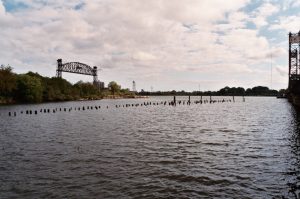
By Bryan Luukinen
Last summer, staff from the Duke Superfund Research Center (SRC) staff packed their bags in Durham and drove up to the Hampton Roads area of Virginia to talk to anglers fishing in the Elizabeth River. Their goal: to find out more about the anglers’ fishing habits and if they knew about fish consumption advisories in the river. Why? The Elizabeth River has a long legacy of industrial activity and pollution. We wanted to make sure the anglers understood their potential for exposure to environmental contaminants.
Our Research and the River
Duke SRC Director Richard Di Giulio and his colleagues have been doing research in the Elizabeth River area of Virginia for many years. The focus of their work is understanding the effects on wildlife of polycyclic aromatic hydrocarbon (PAH) contamination in the River from three prominent creosote wood treatment facilities (now closed): Atlantic Wood Industries; Republic Creosote, and Eppinger & Russell. Dr. Di Giulio’s research has evaluated the responses of aquatic animals, specifically the Atlantic killifish, or mummichog (Fundulus heteroclitus), to those chemicals and other environmental stressors.
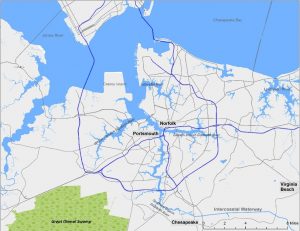
Polychlorinated biphenyls (PCBs) are another contaminant in the Elizabeth River. PCBs are industrial chemicals that are no longer produced, but are very persistent in the environment, and are toxic, especially to developing organisms. As a result of this contamination, active fish consumption advisories are posted for PCB contamination in the Elizabeth River. We wanted to know whether people who fish in the River were aware of the advisories, and what are their typical fish consumption habits. RTC staff conducted surveys during summer 2015 with anglers on the banks of the River and on bridges spanning the. We also used email to survey 13,000 anglers in the area who had registered for fishing licenses.
Fish Tissue Sampling
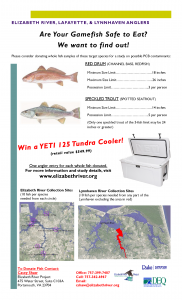
In addition to our survey work on the Elizabeth River, Duke SRC received supplemental funding from NIEHS to test for PCBs in fish tissue from red drum and speckled trout, two commonly caught fish in the Elizabeth River that had not previously been tested. The red drum (also called channel bass, puppy drum, or redfish) can weigh far upwards of 40 pounds, though they are commonly smaller. They spend the early part of their lives in estuaries like the Elizabeth River, then breed in coastal waters at maturity. Speckled trout (also called spotted seatrout) are typically 15 to 25 inches in length and 2 to 4 pounds, but they can be as large as 40 inches and 12 pounds. Speckled trout range from New York to northern Mexico and are found in rivers, estuaries, and shallow coastal waters. We also collected tissue samples from the Atlantic killifish. The killifish are much smaller, approximately 3 inches in length and between 8 ounces to a pound in weight. They are also far less mobile than the other species, staying in a home range smaller than 50m. As such, they provide a better indication of potential sources of PCBs into the Elizabeth River than the migratory drum and trout.
To learn more about the fish and their contaminant levels, we asked anglers to donate tissue samples from fish they caught in the Elizabeth and Lafayette; in return, the anglers were entered into a drawing for a fishing cooler. We worked with colleagues at the Virginia Institute for Marine Sciences and their certified PCB testing laboratory to test fish tissue samples (as composites). In total, we collected 98 fish from 7 locations for drum and speckled trout, and sampled killifish from 19 stations, taking 30 fish at each station. The fish were then composited into location-specific samples and evaluated for the presence of PCBs. Our preliminary analysis of the data suggest that most samples are below levels of concern, but the data are currently undergoing a more rigorous statistical analysis.
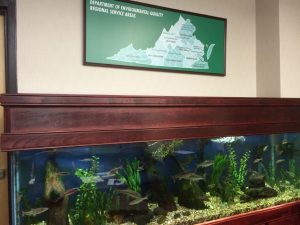
Learning About Anglers
We obtained sixty completed surveys from the Elizabeth River anglers, and over 300 surveys from the fishing license list. We’ve been working to analyze those data since last summer, and we’re making great progress. We conducted a preliminary evaluation of the surveys and shared those results with the Elizabeth River Project (ERP) and VA Department of Environmental Quality (DEQ) in April, 2016. Later in April, Charlotte Clark and Bryan Luukinen also presented our preliminary findings to the Superfund Fish Advisory Information Network (FishNet). RTC staff are currently working to evaluate food preparation methods and cultural competence of fish consumption advisories (FCA) for populations that may have limited understanding of FCA.
So, what did we find? Our early findings indicate that most of the anglers were unaware of the fish consumption advisories. Knowledge of fish consumption advisories by both the shoreline anglers and the online respondents was limited, with 34% and 37% of the anglers, respectively, saying that they were aware of the advisories. Our findings also indicate that the anglers don’t have a good understanding of what the advisories mean. When we asked the two groups whether they thought that health risks exist from consuming the fish in the Elizabeth River, 30% of shoreline anglers and 50% of online respondents thought that health risks existed from consuming these fish.
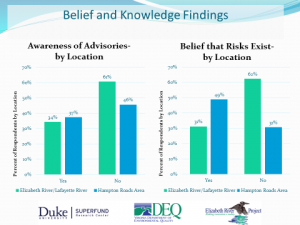
What’s Next?
Our initial findings tell us that work needs to be done to better communicate these advisories. To start, our colleagues at the Elizabeth River Project have shared our preliminary findings with angler groups in the Elizabeth River area. We are also working with our colleagues at the VA DEQ and VA Department of Health to help them find ways to better communicate the advisories and to reach a larger audience of anglers, with the goal of preventing early life exposures to PCBs and other contaminants that may have later life consequences.





